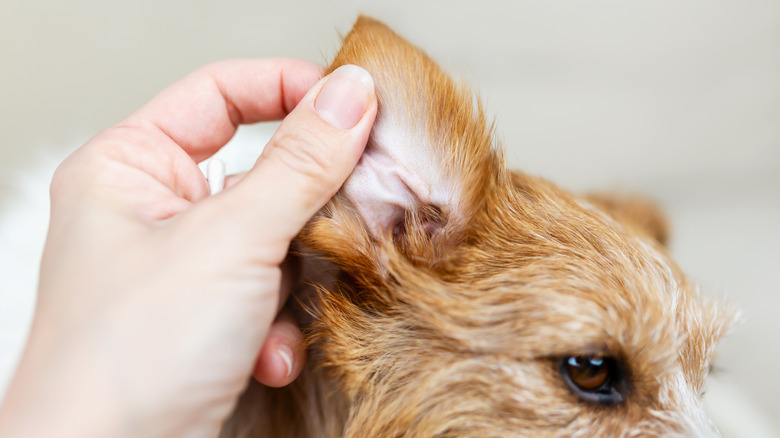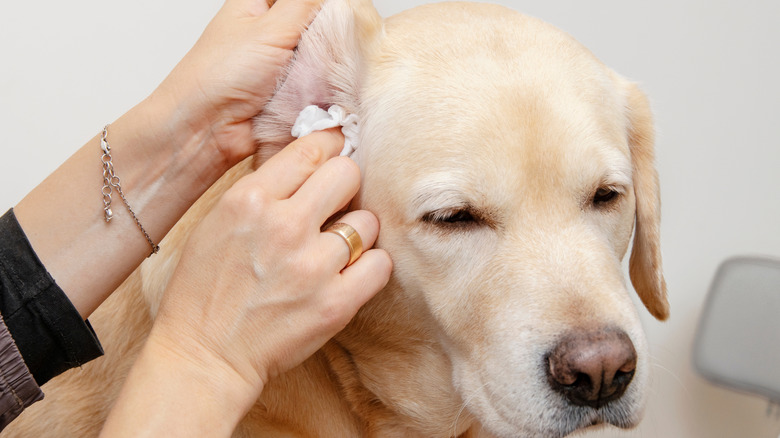Never Try This One Home Remedy To Get Rid Of Ear Mites In Dogs
We may receive a commission on purchases made from links.
Finding any sort of infestation on a pet can instantly concern an owner. One prevalent pest is otodectes cynotis, better known as ear mites. These tiny arachnids thrive in dogs' ears and can cause itchiness, inflammation, and a build-up of gunk that can become further aggravated by a dog scratching. Mites also present a challenge in a multi-pet household, as ear mites are one of many diseases that can spread between dogs and cats.
Finding ear mites may lead a pet parent to act rashly to help their pet. While many equate hydrogen peroxide as a multipurpose disinfectant that people also use for various home treatments, it should not be used to treat ear mites in dogs or any other ear-related issues. Hydrogen peroxide kills bacteria, but the fizzing that comes with it — resulting from contact with skin cells, blood, and bacteria — can be very stressful to a dog not expecting a loud sound as a dog's hearing is much more sensitive than a human's.
Stress from noise is disconcerting, but using hydrogen peroxide has more severe side effects. Notably, peroxide does not discriminate in what it kills and can also damage fibroblasts, cells that are essential in aiding the natural healing process of wounds. Moreover, once the peroxide has killed bacteria, it turns into water, the perfect breeding ground for bacteria that can lead to infections. Peroxide should not be used to treat ear mites. Instead, a veterinarian can assess the issue and provide an approved ear-cleaning solution or medicine.
How to identify ear mites
Ear mites can burrow themselves into a dog's ear, so you are unlikely to notice them even if you look for them closely. These pests are tiny; spotting one will only appear as a small black dot moving within your dog's ear. However, their size and location make it more likely that a pet owner will notice the results of the infestation over the actual ear mite.
Sores or crusty black debris can be telltale signs that a dog has ear mites. Other symptoms can include head shaking, redness, inflammation, a strong odor from the dog's ears, and excessive scratching. These symptoms can be similar to other infections, such as yeast or bacteria, making it challenging for a pet parent to determine the root of a dog's ear issues. The best practice is to bring your pet to a veterinarian to assess the source of the problem, whether you expect ear mites to be the cause or not.
How to prevent ear mites in dogs
The best way to avoid ear mites at home is to take preventive measures in advance. Knowing how often to clean your dog's ears based on their needs will remove gunk and residue, reducing the risk of infections, including ear mites. Unless advised otherwise by a veterinarian, non-medicated dog ear cleaners are preferable. These products will be gentler on a dog's ears, and buying ear cleaners to treat issues a dog does not have is unnecessary. Vet-recommended options include Virbac Epi-Otic Advanced Ear Cleanser and Earthbath Dog Ear Wipes. The cleaning process is straightforward, as highlighted in a video from White Cross Vets.
In addition to in-ear medications, topical applications can help deter fleas, ticks, and mites (yes, there's a difference!) from latching onto a pet, and your veterinarian can prescribe these. Flea, tick, and heartworm preventative medicine can also reduce the chances of ear mites. Finally, keeping a dog's personal space clean and paying attention to their ears after playing with other animals or spending time outdoors are practical ways to avoid ear issues. Despite a pet parent's best efforts, ear mites can still happen, but these measures can help mitigate the chances of problems occurring; ensuring you never use hydrogen peroxide to treat or prevent ear mites.
Always consult your veterinarian before making changes to your pet's diet, exercise, or care. To find an accredited veterinarian in your area, you can search the American Animal Hospital Association's online database.


